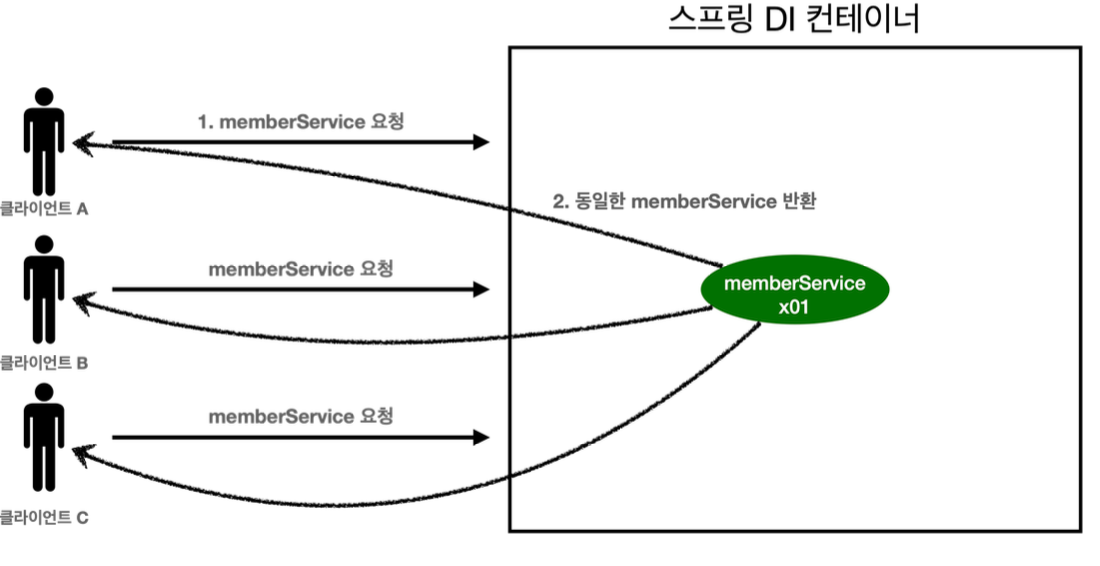싱글톤 패턴
- 클래스의 인스턴스가 딱 1개만 생성되는 것을 보장하는 디자인 패턴
- private 생성자를 사용해서 외부에서 임의로 new 키워드를 사용하지 못하도록 막아야 함
SingletonService
package hello.singleton;
public class SingletonService {
private static final SingletonService instance = new SingletonService();
public static SingletonService getInstance(){
return instance;
}
private SingletonService(){
}
public void logic(){
System.out.println("싱글톤 객체 로직 호출");
}
}Test
package hello.singleton;
import hello.core.AppConfig;
import hello.core.member.MemberService;
import org.assertj.core.api.Assertions;
import org.junit.jupiter.api.DisplayName;
import org.junit.jupiter.api.Test;
import org.springframework.context.ApplicationContext;
import org.springframework.context.annotation.AnnotationConfigApplicationContext;
import java.lang.annotation.Annotation;
import static org.assertj.core.api.Assertions.*;
public class SingletonTest {
@Test
@DisplayName("싱글톤 패턴을 적용한 객체 사용")
void singletonServiceTest(){
SingletonService singletonService1 = SingletonService.getInstance();
SingletonService singletonService2 = SingletonService.getInstance();
System.out.println("singletonService1 = " + singletonService1);
System.out.println("singletonService2 = " + singletonService2);
assertThat(singletonService1).isSameAs(singletonService2);
}
}결과

- 호출할 때마다 같은 객체 인스턴스를 반환
문제점
- 싱글톤 패턴을 구현하는 코드 자체가 많이 들어감(SingletonService.java)
- 의존관계상 클라이언트가 구체 클래스에 의존(DIP 위반)
- 내부 속성을 변경하거나 초기화가 어려움
- private 생성자로 자식 클래스를 만들기 어려움
- 유연성이 떨어짐
- 안티패턴으로 불리기도 함
싱글톤 컨테이너
- 스프링 컨테이너는 싱글톤 패턴을 적용하지 않아도 객체 인스턴스를 싱글톤을 관리
- 스프링 컨테이너는 싱글톤 컨테이너 역할을 함. 이렇게 싱글톤 객체를 생성하고 관리하는 기능을 싱글톤 레지스트리라고 부름
- 싱글톤 패턴을 위한 코드가 들어가지 않아도 됨
- DIP, OCP, 테스트, private 생성자로부터 자유롭게 싱글톤 사용 가능
Test (스프링 컨테이너 적용)
package hello.singleton;
import hello.core.AppConfig;
import hello.core.member.MemberService;
import org.assertj.core.api.Assertions;
import org.junit.jupiter.api.DisplayName;
import org.junit.jupiter.api.Test;
import org.springframework.context.ApplicationContext;
import org.springframework.context.annotation.AnnotationConfigApplicationContext;
import java.lang.annotation.Annotation;
import static org.assertj.core.api.Assertions.*;
public class SingletonTest {
@Test
@DisplayName("스프링 컨테이너와 싱글톤")
void springContainer(){
// AppConfig appConfig = new AppConfig();
ApplicationContext ac = new AnnotationConfigApplicationContext(AppConfig.class);
MemberService memberService1 = ac.getBean("memberService", MemberService.class);
MemberService memberService2 = ac.getBean("memberService", MemberService.class);
// 참조값이 다른 것을 확인
System.out.println("memberService1 = " + memberService1);
System.out.println("memberService2 = " + memberService2);
// memberService1 != memberService2
assertThat(memberService1).isSameAs(memberService2);
}
}결과

AS-IS, TO-BE


무상태(Stateless) 설계
- 객체 인스턴스를 하나만 생성해서 공유하는 싱글톤 방식은 여러 클라이언트가 하나의 객체 인스턴스를 공유하기 때문에 싱글톤 객체는 상태를 유지(Stateful)하게 설계하면 안됨
- 무상태(Stateless)로 설계
- 특정 클라이언트에 의존적인 필드가 있으면 안됨
- 특정 클라이언트가 값을 변경할 수 있는 필드가 있으면 안됨
- 가급적 읽기만 가능
- 필드 대신에 Java에서 공유되지 않는 지역변수, 파라미터, ThreadLocal 등을 사용
StatefulService
package hello.singleton;
public class StatefulService {
private int price; // 상태를 유지하는 필드
public void order(String name, int price){
this.price = price;
}
public int getPrice(){
return price;
}
}Test
package hello.singleton;
import org.assertj.core.api.Assertions;
import org.junit.jupiter.api.Test;
import org.springframework.context.ApplicationContext;
import org.springframework.context.annotation.AnnotationConfigApplicationContext;
import org.springframework.context.annotation.Bean;
import static org.junit.jupiter.api.Assertions.*;
class StatefulServiceTest {
@Test
void statefulServiceSingleton(){
ApplicationContext ac = new AnnotationConfigApplicationContext(TestConfig.class);
StatefulService statefulService1 = ac.getBean(StatefulService.class);
StatefulService statefulService2 = ac.getBean(StatefulService.class);
//ThreadA : 10000원 주문
statefulService1.order("userA", 10000);
//ThreadB : 20000원 주문
statefulService2.order("userB", 20000);
//ThreadA: 사용자A 주문 금액 조회
int price = statefulService1.getPrice();
System.out.println("price = " + price);
Assertions.assertThat(statefulService1.getPrice()).isEqualTo(20000);
}
static class TestConfig{
@Bean
public StatefulService statefulService(){
return new StatefulService();
}
}
}결과

- StatefulService의 공유 필드 price는 특정 클라이언트가 값을 변경
- userA의 주문금액이 10,000원이 아닌 20,000원이 됨
- 무상태(Stateless)로 설계 필요
'Java > Spring Basic' 카테고리의 다른 글
| @ComponentScan (0) | 2024.08.21 |
|---|---|
| @Configuration (0) | 2024.08.20 |
| 스프링 컨테이너 (0) | 2024.08.17 |
| AppConfig (0) | 2024.08.15 |
| 좋은 객체 지향 설계의 5가지 원칙(SOLID) (0) | 2024.08.13 |